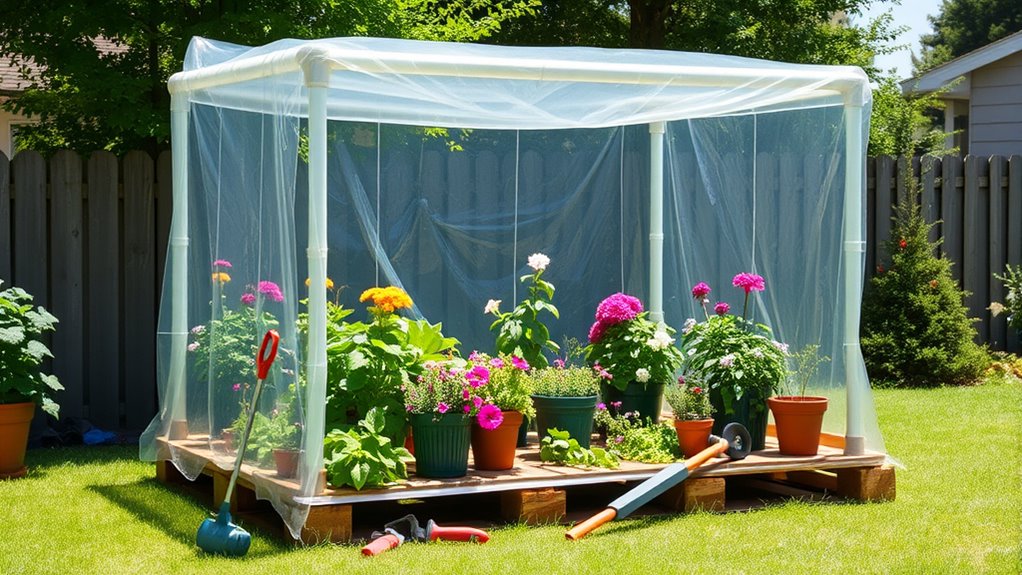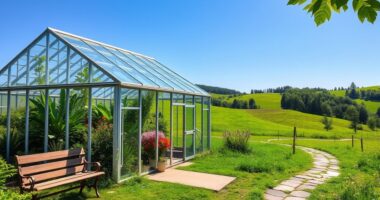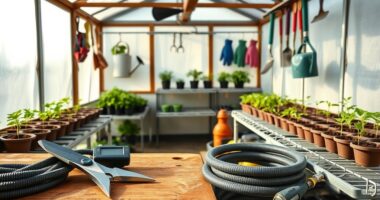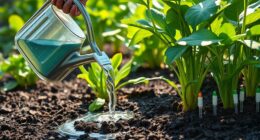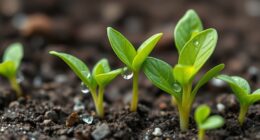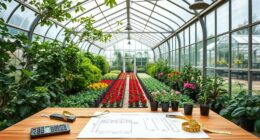To build a DIY greenhouse for under $100, start by choosing a simple design, like a lean-to or arched PVC model. Gather affordable or recycled materials, such as old windows and pallet wood. Use essential tools like a hammer and drill for construction. Prepare a sunny, level site and install proper ventilation. Focus on managing temperature and humidity. Finally, select easy-to-grow plants. There’s plenty more you can learn to make your greenhouse thrive!
Key Takeaways
- Use recycled materials like old windows and pallet wood to significantly cut costs while building your greenhouse.
- Choose a simple design, such as a miniature or arched PVC greenhouse, to minimize expenses.
- Prepare a sunny, level site with gravel flooring for affordable drainage and easy relocation.
- Utilize basic hand tools like a hammer and tape measure, along with a power drill for efficient assembly.
- Implement cost-effective temperature management techniques, like bubble wrap insulation or shade cloth, to maintain optimal conditions.
Choosing the Right Design for Your Greenhouse

When you’re planning to build a greenhouse, choosing the right design can make all the difference in your gardening success.
Consider a lean-to greenhouse if you have limited space; it utilizes existing structures for support and can be easily constructed with recycled materials.
A lean-to greenhouse is perfect for small spaces, leveraging existing structures and recycled materials for easy construction.
For flexibility, a modular greenhouse allows you to expand or modify your setup, making it a cost-effective choice.
If you’re new to gardening, a miniature greenhouse is perfect for small yards, offering a compact space for a few plants.
Alternatively, an arched PVC greenhouse provides a lightweight and budget-friendly option, while a recycled window greenhouse gives your yard a unique touch.
Each design caters to different needs and preferences, so pick one that suits you best!
Sourcing Affordable Materials

When you’re building your greenhouse, consider using recycled materials to cut costs.
Check local hardware stores for affordable options and sales on essential supplies.
Recycled Material Options
Building your DIY greenhouse on a budget can be both fun and eco-friendly by sourcing recycled materials.
Start by collecting old windows for walls, which provide great natural light. Pallet wood works well for framing—often, you can find them for free.
Consider repurposing plastic containers, like bottles or tubs, as mini greenhouses for your plants. You can also reuse old greenhouse plastic to cover your structures.
Don’t overlook scrap lumber from local construction sites, as it can be perfect for framing. For a unique touch, scout Habitat for Humanity stores for affordable doors and windows.
Local Hardware Stores
Local hardware stores are treasure troves for sourcing affordable materials for your DIY greenhouse.
You’ll find everything from lumber to fasteners that won’t break the bank. Don’t forget to explore discounted sections where you can snag great deals. Buying in bulk can also save you a few bucks, especially on essentials like nails and screws.
Here are some materials you should look for:
- 2×4 Lumber: Ideal for framing your greenhouse.
- Greenhouse Plastic: Perfect for covering and insulation.
- Used Materials: Check for second-hand items that can be repurposed.
With a bit of creativity and resourcefulness, you can gather everything you need without exceeding your budget. Additionally, consider checking for eco-friendly options that align with sustainable gardening practices.
Happy building!
Essential Tools for Construction

Constructing your DIY greenhouse requires a solid set of tools to secure the project runs smoothly.
Start with essential hand tools like a hammer for driving nails, a tape measure for accurate measurements, and a level to confirm everything’s even. Pliers and a wrench will help you grip and tighten small components.
For power tools, a drill is vital for making holes, while an impact driver can drive larger screws efficiently. A miter saw will allow for precise cuts.
Don’t forget safety equipment like safety glasses, work gloves, and steel-toed boots to protect yourself.
Finally, gather fasteners like nails, screws, and bolts, along with lumber and covering materials to complete your greenhouse construction.
Step-by-Step Construction Guide

Creating your DIY greenhouse can be an enjoyable and rewarding project, and following a clear step-by-step guide will make the process easier.
Building your own greenhouse can be a fun and fulfilling project with a straightforward guide to follow.
Start by designing a lean-to greenhouse using recycled materials like old windows and lumber. Assemble a simple frame with 2x4s, ensuring it’s sturdy enough to support the covering. Cover the frame with UV-resistant polythene for insulation and light transmission. Additionally, consider the benefits of extending your gardening season, as this can greatly improve your harvest yield.
Here’s a quick checklist to guide you:
- Assemble the frame around windows or doors for walls.
- Secure the polythene cover with tape or clips.
- Include at least one venting window for proper ventilation.
Preparing the Site for Your Greenhouse

After assembling your greenhouse frame, the next step is to prepare the site where it will stand.
Choose a sunny location with the longest side facing south, and avoid any areas that may pose hazards, like falling tree branches.
Ascertain the ground is level and clear of vegetation or debris to prevent water pooling.
Maintain at least a foot of clearance around the greenhouse for easy access and maintenance.
If possible, place your greenhouse near water and electricity sources for convenience.
For flooring, consider using gravel with specialized greenhouse material for good drainage.
This approach keeps costs down and allows for easy relocation if needed, making your greenhouse setup efficient and effective.
Installing Ventilation and Access Points

Proper ventilation and access points are essential for maintaining a healthy greenhouse environment.
You’ll want to take into account both active and passive ventilation methods to guarantee proper airflow. Strategically placing windows and doors for ideal access and ventilation improves the greenhouse’s efficiency.
- Choose exhaust fans and circulation fans based on the greenhouse size, confirming the total fan capacity is twice the floor area in CFM.
- Install vents that can be opened manually or automatically to regulate airflow easily.
- If you’re on a budget, think about using repurposed materials for your access points to save costs.
Managing Temperature and Humidity

As you set up your greenhouse, managing temperature and humidity becomes essential for plant health and growth.
Start by installing heating systems like small space heaters for colder months and cooling systems such as evaporative cooling or fan pads during hot days. Incorporating air purifiers can also enhance air quality, which is beneficial for plant health. Utilizing solar-powered solutions can also provide an eco-friendly way to power your greenhouse systems. Understanding the importance of hydration and nutrition is crucial for maintaining healthy plants in your greenhouse. Additionally, using airtight coolers can help retain optimal conditions for sensitive plants if you need to store them temporarily.
Shading techniques, like shade cloth, help filter sunlight and prevent overheating. Make certain your greenhouse is well-insulated to retain heat.
For humidity, use digital hygrometers to monitor levels and implement misting systems to maintain ideal moisture. Consider using smart controllers for remote adjustments and alarms for extreme temperature changes. Balancing humidity is critical to prevent pathogens while guaranteeing nutrient absorption, so pay close attention to these fundamental factors for a thriving greenhouse environment. Additionally, incorporating energy-efficient systems can significantly lower operational costs while effectively managing temperature and humidity.
Selecting the Best Plants for Your Greenhouse

What types of plants should you consider for your greenhouse? Choosing the right plants is essential for a thriving greenhouse. Depending on your climate and preferences, here are some great options to grow:
- Fruit-bearing plants: Consider bananas, strawberries, and Meyer lemons for delicious rewards.
- Vegetable crops: Tomatoes and peppers thrive in the consistent heat, ensuring a bountiful harvest.
- Unusual crops: Try growing melons or luffas for something unique and fun.
Remember to think about the conditions in your greenhouse. Opt for plants that suit your environment, whether it’s tropical or cooler.
With the right selection, you’ll enjoy a vibrant and fruitful greenhouse experience!
Tips for Ongoing Maintenance and Care

To keep your greenhouse thriving, you need to stay on top of ventilation and temperature management.
Regular checks will help you maintain ideal conditions for your plants.
Additionally, adjusting your plant selections with the seasons guarantees they get the care they need throughout the year.
Regular Ventilation Checks
Regular ventilation checks are essential for keeping your greenhouse environment healthy and thriving.
Proper airflow regulates temperature and humidity, promoting robust plant growth. Make it a habit to inspect your ventilation systems regularly, especially as seasons change.
- Clean Vents: Remove any debris or blockages to guarantee ideal airflow.
- Adjust Settings: Modify ventilation methods based on current weather conditions and plant requirements.
- Monitor Conditions: Use thermometers and hygrometers to track temperature and humidity levels.
Temperature Management Techniques
Effective temperature management is essential for creating an ideal growing environment in your DIY greenhouse.
Start by insulating with bubble wrap or plywood to retain heat during colder months. Consider using thermal curtains at night to keep warmth in, and repurpose old windows or plastic bottles for added insulation.
For heating, ductless heat pumps and thermal mass materials like water barrels can effectively manage temperature.
In hot weather, utilize shade cloth and evaporative cooling methods, such as misting systems, to lower temperatures.
Automate your temperature control with smart controllers and sensors for precise adjustments.
Regularly check and maintain these systems to guarantee your plants thrive year-round.
Seasonal Plant Adjustments
As the seasons change, adjusting your greenhouse care routine becomes essential for nurturing your plants.
Here’s how to keep your greenhouse thriving throughout the year:
- Spring: Prepare by cleaning tools, starting seeds, and testing your irrigation system.
- Summer: Increase watering, install shade cloths, and monitor for pests to guarantee your plants thrive in the heat.
- Fall: Clear out summer crops, adjust irrigation, and plant cool-season varieties to prepare for winter.
- Winter: Insulate your greenhouse, protect plants with row covers, and maintain air circulation to prevent mold.
Frequently Asked Questions
Can I Build a Greenhouse in an Apartment Balcony?
Yes, you can build a greenhouse on your apartment balcony!
Start by evaluating the space and sunlight available. Use clear materials like shower curtains or plastic sheets to maximize light while providing protection.
Make certain proper ventilation to keep plants healthy. Lightweight options like wooden rods and hooks make installation easy.
Get creative with mini greenhouse ideas, like repurposing containers, to optimize your small space for growing fresh herbs and vegetables.
How Long Will a DIY Greenhouse Typically Last?
A DIY greenhouse can typically last anywhere from one to fifteen years, depending on the materials you choose and how well you maintain it.
For instance, plastic greenhouses often last one to three years, while polycarbonate structures can endure five to fifteen years with proper care.
Regular maintenance, including cleaning and structural checks, is essential to prolong its lifespan.
Is It Possible to Heat a Greenhouse Without Electricity?
Heating a greenhouse without electricity is like nurturing a garden with the sun’s embrace.
You can use methods like insulation—straw bales and water barrels act as your allies in retaining warmth.
Embrace solar energy for passive heating during the day, and consider composting for that extra boost.
While temperature fluctuations can challenge you, these natural techniques create a cozy environment for your plants, ensuring they thrive even in the coldest months.
What Plants Grow Best in a Small Greenhouse?
In a small greenhouse, you’ll find that certain plants thrive better than others.
Consider succulents like lithops and cacti for low maintenance.
Dwarf vegetables, such as tomatoes and peppers, are perfect for compact spaces.
Flowering plants like African violets and kalanchoe add color without taking up much room.
For a burst of flavor, herbs like mint and rosemary flourish well.
Keep humidity levels in mind for ferns and orchids, ensuring they thrive.
Can I Move My Greenhouse Once It’s Built?
Yes, you can move your greenhouse once it’s built, but it takes planning.
First, you’ll need to disassemble it carefully, marking and photographing parts for easy reassembly later.
Choose lightweight materials to make the move easier, and consider your transportation options—small trucks or flatbed trailers work well.
Always check the weather and local regulations before moving.
With the right approach, you can successfully relocate your greenhouse without damaging it.
Conclusion
Building your own DIY greenhouse for under $100 can be as rewarding as watching a seed sprout into a vibrant plant. By following this guide, you’ve got the tools and knowledge to create a thriving space for your favorite plants. Remember, each step you take brings you closer to a lush garden sanctuary. With a little care and maintenance, your greenhouse will flourish, just like your gardening skills. Get started today and watch your green dreams grow!
